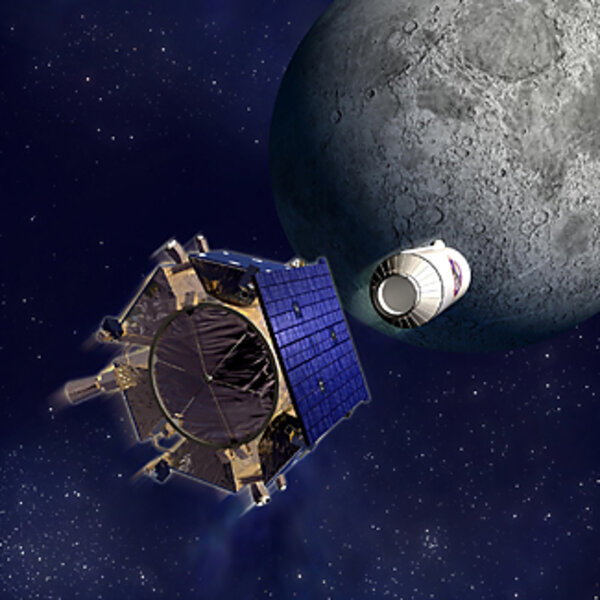NASA moon 'bombing' a plunge into the mystery of lunar water
UPDATE: NASA has successfully "bombed" the moon. Click here to read the story.
NASA is just hours away from punching two new craters in the moon, perhaps proving that water exists in the bottom of a crater at the moon's south pole.
Within the past two weeks, three other moon missions have reported finding evidence for water across virtually the entire surface of the moon. Now, two projectiles are scheduled to slam into one frigid crater – the first at 7:30 a.m. Eastern time Friday – in hopes of confirming that water is there concentrated as ice.
"This is really exciting stuff," says Anthony Colaprete, lead scientist of the mission, called LCROSS. "Who woulda thunk that the moon has a water cycle on it, perhaps," with water concentrations in the moon's surface changing throughout the lunar day.
LCROSS is focusing on "one aspect of that water cycle," says Dr. Colaprete, a researcher at the NASA's Ames Research Center at Moffett Field, Calif.
The LCROSS team is hunting for water ice thought to be concentrated in the moon's freezer trays – polar craters where part or all of the floors never receive sunlight. These cold traps are estimated to be some of the most frigid spots in the solar system.
The findings could be crucial to future exploration. Water represents a precious resource – not just to slake an astronaut's thirst, but for making rocket fuel as well.
Researchers and engineers interested in setting up science outposts or industrial facilities on the moon would no longer have to worry about the cost of launching water or additional fuel from Earth – a very expensive proposition. They could begin planning for expeditions that could at least partly live off the land.
Friday morning, the upper stage of the rocket that helped launch LCROSS and NASA's Lunar Reconnaissance Orbiter will slam into the bottom of a crater called Cabeus. Four minutes later, the crater will absorb another punch, this one from the upper stage's "shepherd" – a package of navigation gear, small thrusters, and sensors that kept the upper stage on course for the impact since launch.
The shepherd will follow the upper stage down, recording the results of the first crash before the shepherd itself crashes 1.9 miles from the first impact site.
The LCROSS team expects crash No. 1 to kick up some 350 tons of material as it slams into the crater floor at roughly twice the speed of a bullet. Once the dust settles, the impact should leave a crater some 65 feet across and 13 feet deep. Crash No. 2 should throw an additional 100 tons or upward and carve a crater perhaps 30 feet across and several feet deep.
The people with the best seats in the house for these events are astronomers at major observatories between St. Louis and Honolulu, where skies will still be dark and the moon will be visible. In addition, a suite of spacecraft – from the Hubble Space Telescope and the Lunar Reconnaissance Orbiter to more obscure craft – will be keeping close tabs on the collisions.
All will be analyzing the plume of material rising out of the crater, as well as the vapor that the crashes will generate, for signs of water itself, as well as hydrogen and hydroxyls. Hydroxyls are one hydrogen atom short of a water molecule.
The observing campaign, which includes amateurs astronomers as well, "is ready to go," said Jennifer Heldmann, a member of the research team coordinating the overall observing effort, during a press briefing Thursday afternoon.
For all the excitement, though, LCROSS's smack-down will be a visual dud for anyone trying to watching through binoculars or telescopes with light-gathering mirrors smaller than about 10 to 12 inches.
"This is not going to be a grand spectacle," acknowledges Colaprete. The diffuse material will be five to 10 times dimmer than the moon's surface.
The ejecta should have a slight shimmer to it, he says, but it's expected to turn a black background only slightly less black.
The best views for most people will be on the web, where NASA will be webcasting the collision. Coverage starts at about 6:30 a.m. Eastern time.
-----
Follow us on Twitter.





